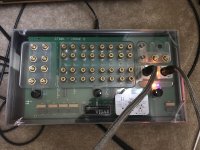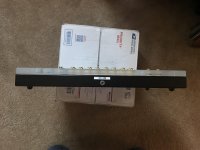This rare Nordost Vidar was not marketed on the retail market but was offered to Nordost dealers to use to enhance the value of their cables by breaking them in for their customers. Unit works wonderfully but the corners of the acrylic top plate are cracked (first photo shows cracks) – thus the low condition rating.
Burn in speaker cables, RCA & XLR interconnects, phono cables with 5 pin DIN connectors or BNC cabling.
Asking $1,000. Originally sold to dealers for $3,500.
From another source, describing the Vidar:
“The VIDAR is constructed using the highest quality parts. Each conductor is fed by a bridge mode amplifier. It uses a total of 44 amplifiers in its circuitry. Each amplifier is held at a very precise voltage. The circuit is designed so that there is no difference in voltages between any of the amplifiers is zero. The VIDAR uses a proprietary combination of composite and complex signals to condition the cables. Parts of the signal oscillate at ultralow frequencies, while other parts are in ultrahigh ranges which extend beyond the range of video frequencies. The signal bounces in a ping-ping ball-like fashion from one end of the cable to the other. During the burn-in process, ultra-low frequencies penetrate deep into the core of the cable. The ultra-high frequencies zip along the surface. This method of signal transmission a set up beat harmonics, or heterodynes, between the two complex waveforms. In the digital domain, this would be referred to as aliasing products. These beat frequencies penetrate all layers of the cable.
The design of the circuitry also has a unique feature which drives electrons above the conductor into the dielectric (or insulation) area. The VIDAR not only sends ping pong signals along the cable, it also sends a similar signal from the centre core to the outer shield in the case of interconnect cables.”
Burn in speaker cables, RCA & XLR interconnects, phono cables with 5 pin DIN connectors or BNC cabling.
Asking $1,000. Originally sold to dealers for $3,500.
From another source, describing the Vidar:
“The VIDAR is constructed using the highest quality parts. Each conductor is fed by a bridge mode amplifier. It uses a total of 44 amplifiers in its circuitry. Each amplifier is held at a very precise voltage. The circuit is designed so that there is no difference in voltages between any of the amplifiers is zero. The VIDAR uses a proprietary combination of composite and complex signals to condition the cables. Parts of the signal oscillate at ultralow frequencies, while other parts are in ultrahigh ranges which extend beyond the range of video frequencies. The signal bounces in a ping-ping ball-like fashion from one end of the cable to the other. During the burn-in process, ultra-low frequencies penetrate deep into the core of the cable. The ultra-high frequencies zip along the surface. This method of signal transmission a set up beat harmonics, or heterodynes, between the two complex waveforms. In the digital domain, this would be referred to as aliasing products. These beat frequencies penetrate all layers of the cable.
The design of the circuitry also has a unique feature which drives electrons above the conductor into the dielectric (or insulation) area. The VIDAR not only sends ping pong signals along the cable, it also sends a similar signal from the centre core to the outer shield in the case of interconnect cables.”
Attachments

Members:
We have removed a number of posts. You are welcome to inquire about the products offered. What you are not free to do is comment the same way as the posts now removed. If you feel a diyAudio rule has been broken, please report it. Other than that, do not comment in such a manner.
Last edited:
- Status
- This old topic is closed. If you want to reopen this topic, contact a moderator using the "Report Post" button.

